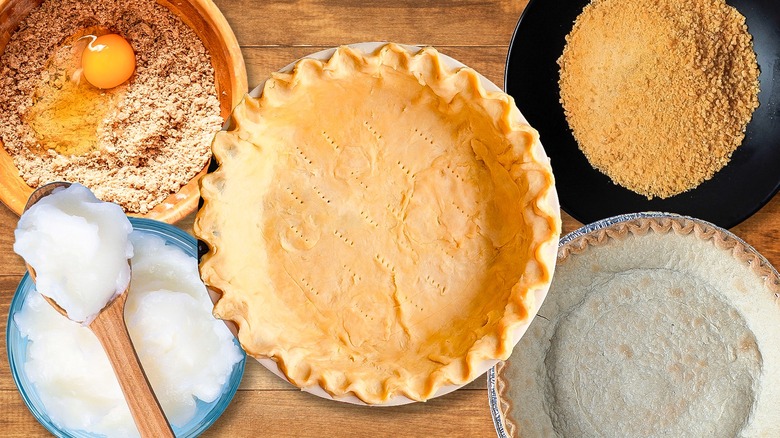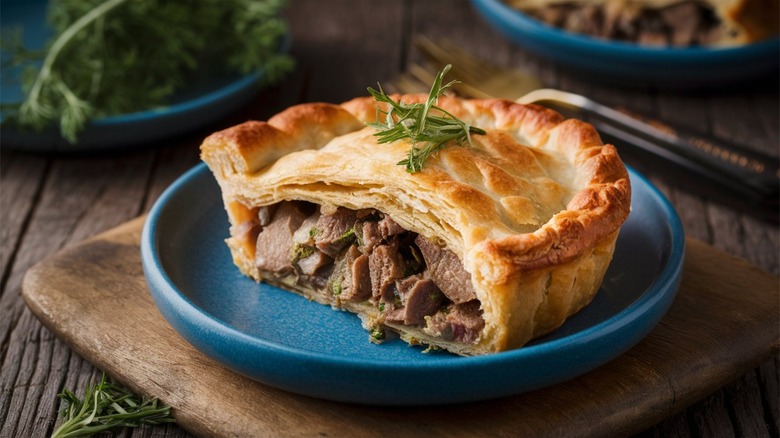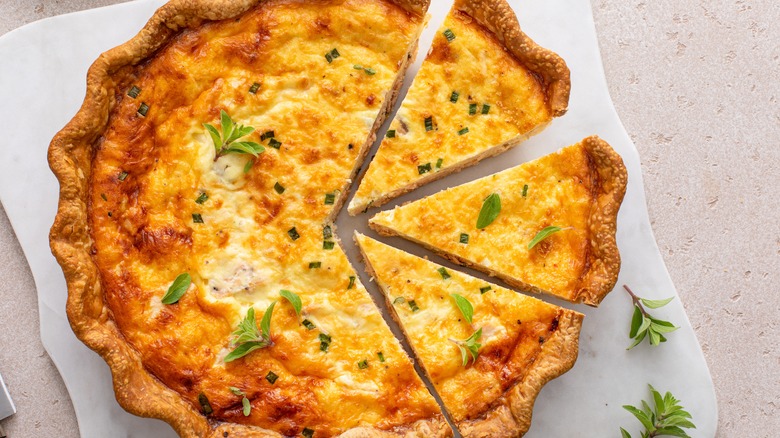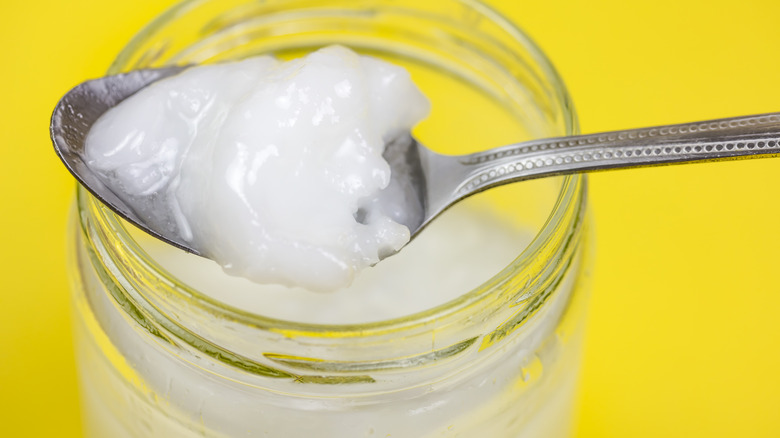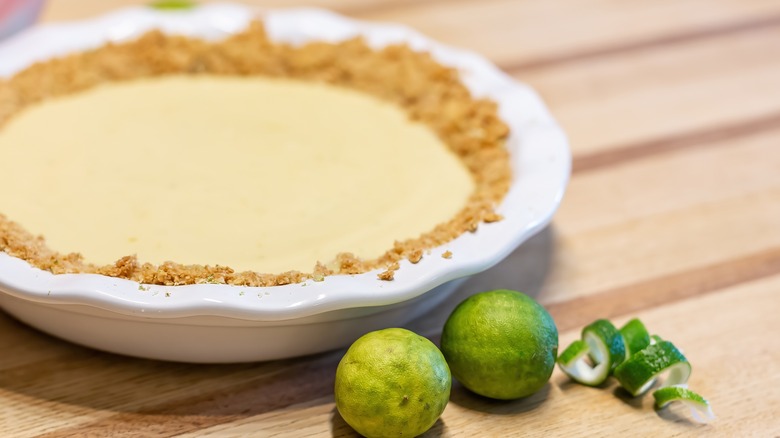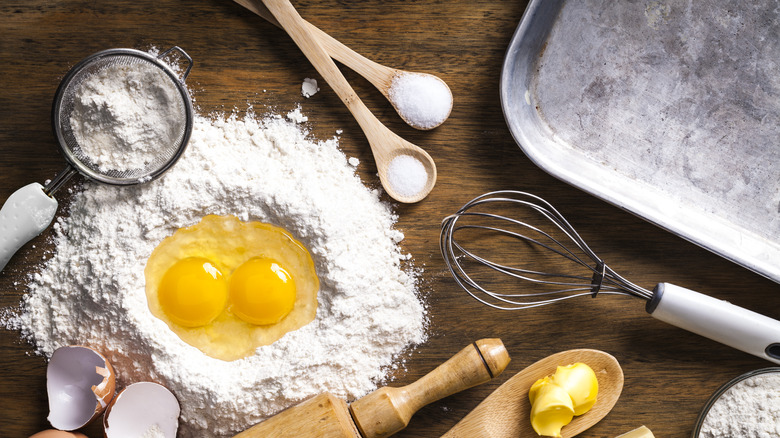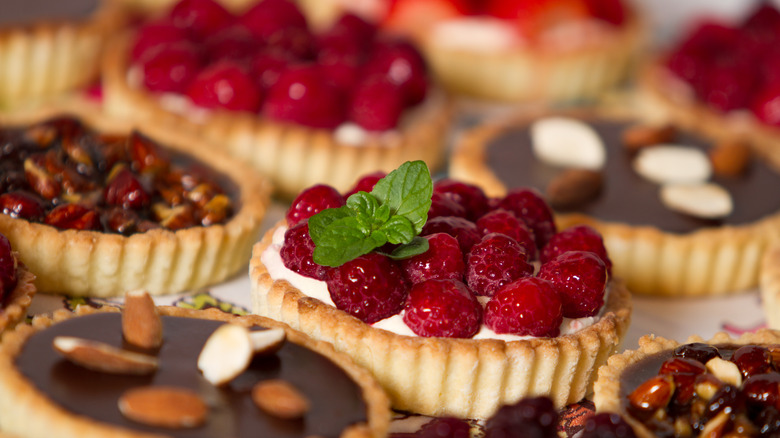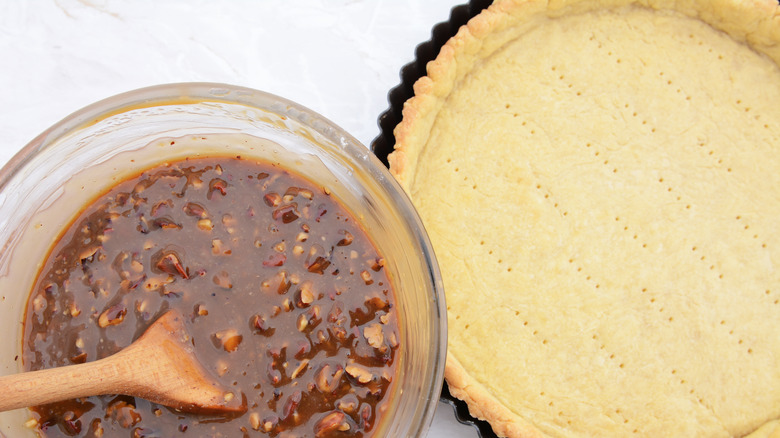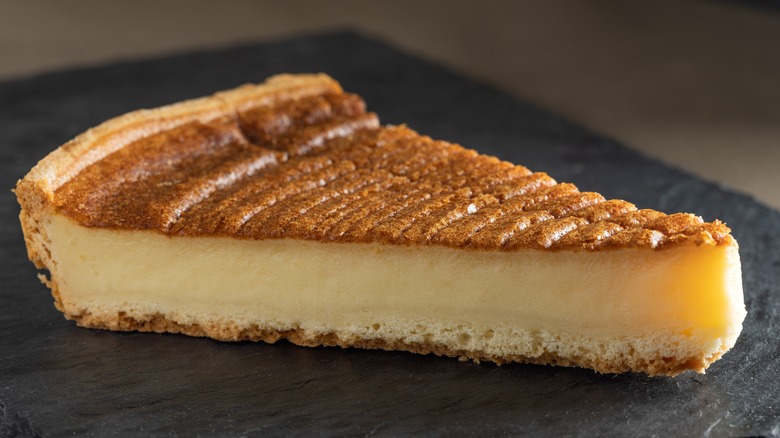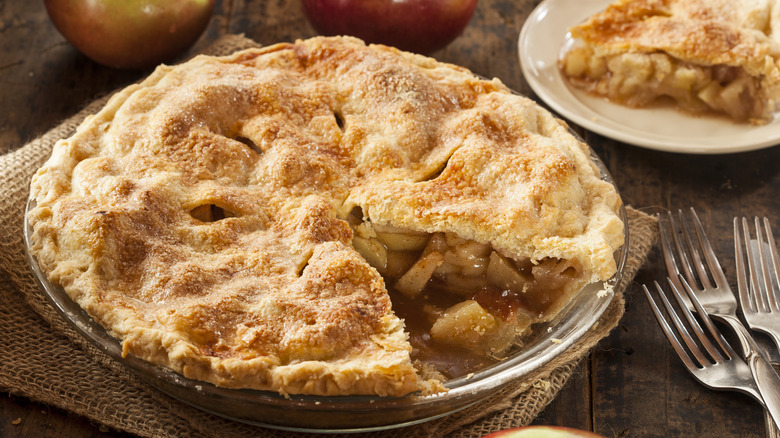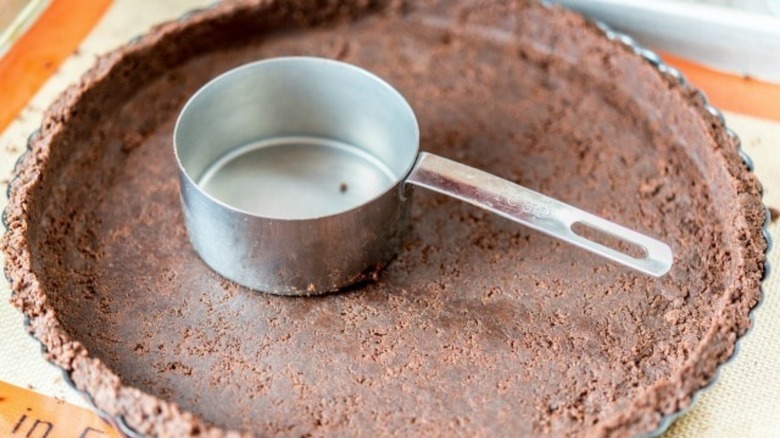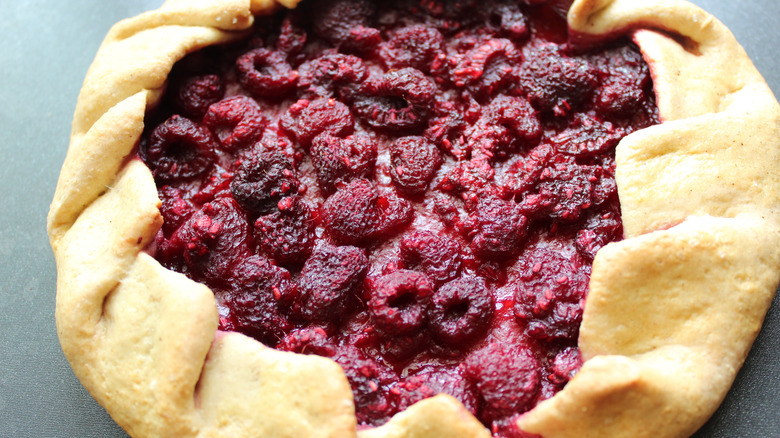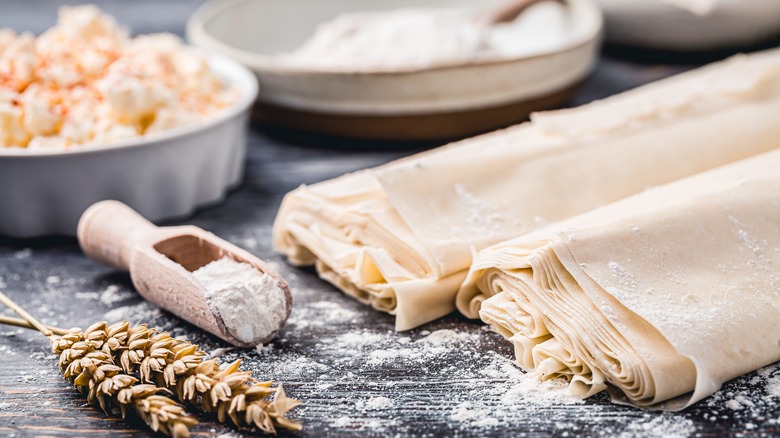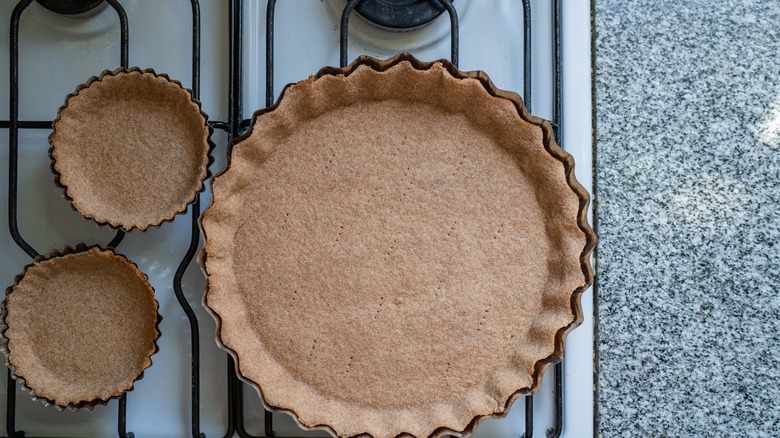How To Choose The Best Pie Crust For Your Next Bake
As a home baker, one of the things that I've come to appreciate is the tastiness and versatility of a pie crust. While most people will opt for the standard pie crust — made with flour, butter, and a little bit of water to bring it together — that's far from the only type of pie crust that you can make. In fact, there is a whole world of different crusts out there, made with different fats, flours, extra ingredients, and techniques, that you can use to transform your grandmother's favorite pie recipe into something truly unexpected.
As someone who has spent years working and experimenting with different pie crusts, I've accumulated a list of important considerations that you should make when you select what type of pie crust you want to use for your recipe. Not only do you have to account for the flavors of your pie filling, but you'll also have to take a good look at the structural considerations to ensure that your pie crust not only serves its purpose as a flavorful exterior to your fillings, but also as the metaphorical and literal vessel for flavor.
Use a hot water crust pastry for meat pies
Meat pies are dense, but man, they sure are tasty. Most of the recipes you'll find online are made with game, beef, lamb, or even mutton. So, as you can imagine, you'll need to select a pie crust that can withstand not only the heft of these pie fillings (along with any other veggies you stuff in there), but also the moisture that's released from the meat cooking and the sauce surrounding it.
The best type of pastry to use for your meat pies is a hot water crust. Hot water crust pastry is made of the same ingredients as your standard pie crust — fat, flour, salt, and water. But in this case, the water and the fat are melted together to act as a strong glue for the dry ingredients. Plus, this method of combining the fat and liquid pre-gelatinizes the starches in the flour, which encourages them to take up more liquid. This means that a hot water crust pastry dough can be more easily shaped into your pan without breaking or cracking.
Since the dough can hold its shape well, you can shape and bake this pie in a high-topped or springform pan and not have to worry about it falling in on itself. If you were to try and make a meat pie in a standard pie crust and remove the dish, you'd have a heap of meat and pie dough on your hands, rather than something that you can feel proud to serve to your dinner guests.
Consider how to pair herbs and spices in your crust with your filling
Adding herbs and spices to your pie crust is a great way to boost its flavors and create synergy between the otherwise bland crust and the tasty fillings. Plus, you can use this technique for many different types of pie crust and experience similar results.
The first important consideration you'll want to make when selecting what herbs and spices to add to your pie crust is what complementary combinations you can find. Sage, for example, can be a great pairing for more than just savory fillings; try adding a few leaves to your apple pie crust and watch its herbaceousness shine. Meanwhile, thyme pairs well with lemon fillings, like in a classic lemon meringue pie, as well as with blueberry fillings. You can also use the same herbs and spices in your quiche crust as its eggy filling; chives, garlic, and dried onion are all fair game.
When you add your herbs to your pie crust, you'll want to be sure to chop them up into small pieces and avoid adding too much of them. Your pie should have a hint of these spices, rather than be wholly dominated by them.
Use coconut oil to replace lard in your pie crust
If you go back to your grandparent's (or even your great-grandparent's) pie crust recipe, you'll typically find one ingredient used rather prominently: lard. Don't get me wrong, lard is an exceptional fat to use in your pie crust. It will seamlessly integrate into your flour and make things easy to work with. Plus, you'll get an impressive stack of layers that cannot be replicated by many other fats — except for one.
Coconut oil is a great substitute for lard in a pie crust when you either can't find lard or are making a plant-based crust. Coconut oil is highly saturated, like lard, so it will impart a similar texture and consistency to the crust. You'll, of course, want to use cold-ish oil to ensure it's in its solid state. You should also opt for a refined coconut oil so you don't get as much of the tropical flavor.
Whenever I make vegan pie crusts at home, coconut oil is one of the fats I grab. I'll also include some vegan butter to mimic some of that flavor and mouthfeel, but I find that coconut oil provides enough structure to hold the flour together without rendering the crust too greasy.
Some sweet pies can use a crumb crust
If you're whipping up a no-bake pie crust or are just looking for an easy way to switch up your custard pie's routine, turn to a crumb crust. Unlike traditional pie crusts, which are made by mixing the fat into the flour, crumb crusts can be easily whipped up by mixing together a melted fat (often butter) with pre-made cookies or crackers. The texture is much more coarse and mealy, but it can be the element that your soft pie filling really needs to help it shine.
The go-to for many is a graham cracker crust. This is relatively expected, considering that you can pick up a graham cracker crust from the grocery store for a couple of bucks. But you can always switch up your routine by making a flavorful crumb crust with your favorite cookie. As long as the cookie is crunchy and dry, it can be used in your pie crust. For one, you can try making a gingersnap cookie crust for your pumpkin pie, or opt for a Nutter Butter crust for your no-bake peanut butter pie.
Try a tender pie crust for lattice work
Once you feel comfortable with shaping and making your pie crust, you may want to step things up with some decorative lattice work. This involves essentially manipulating the top layer of your crust, so you'll want to find a crust that can really hold up to all that movement and shaping. The answer? Tender pie crust.
My go-to way to make pie crust tender is to add eggs to it. The extra fat and protein help keep this dough super pliable, which makes for easy shaping and cutting. You'll want to avoid adding too much egg to this recipe, as it can make your dough a little too loose and cake-like. Rather, you can use about half a beaten egg and a little splash of vinegar to help give you the stretch that you need. And the best part is that you can allocate that other half of the egg to use as a wash; this will ensure your top crust comes out perfectly golden brown.
Pâté sablée needs a light filling
While it might be slightly out of the pie baker's wheelhouse, you can always take your newfound bakery passion to try out some delicate French tarts. In order to master these beautiful pastries, you'll have to try your hand at working with pâté sablée. Unlike standard pie crust, which is made by mixing in the solid fat with the flour, pâté sablée makes things a bit more complicated; it requires that a baker cream together butter with powdered sugar and egg. It's kind of like making a cookie dough, which means that this crust will give you less of a flaky bite than other pie crust varieties.
Pâté sablée is very sweet and flavorful, so it can complement a mild-flavored filling brimming with creamy, citrusy, and floral notes. Avoid heavy fillings with this pie crust, as you want its light flavor to shine through.
No-bake pies need a blind bake
While this isn't a type of pie crust per se, you'll need to decide if you need to blind bake it or not. Blind baking is the process that allows you to get a decent color and bake on your pie crust before you add in your fillings. If you're working with a no-bake pie that does not need to be returned to the oven to finish, like a Kool-Aid pie or a whipped cream cheese pie, all you need to do is prick the bottom crust with a fork to prevent the steam from causing the crust to rise. Then, add a layer of parchment paper, pile on the ceramic pie weights or dried beans, and bake your crust to your heart's content.
In theory, you could blind bake crusts beyond your standard pie crust; it's common practice to do for graham cracker crusts to set them. For example, a no-bake tart (made with pâte sablée) may require a blind bake to ensure that the bottom crust sets.
Par-baking will give you the upper hand on custard-filled pies
Sometimes, you don't need to go all-out and blind bake your crust. Instead, you can par-bake it, which refers to the process of putting your pie in the oven long enough for it to get some color and set, but not so long that it cooks through thoroughly. This method of baking your pie crust is important for custard pies, like pumpkin pie, as well as those that need a little bit of a head start, like pecan pie. If you put your crust and filling in at the same time, you'd potentially end up with an undercooked shell and a stodgy, overcooked filling.
If you're working with a filling that's a little bit more well-suited to heat, you can also try your hand at three-stage baking. You'll start baking your pie at a high heat, before bringing down the temperature for the middle of the bake, and then turning things up again at the end to blast your crust until it's golden brown. It's like the equivalent of moving meat between the heat zones of a grill.
To decide if your crust needs a par-bake, consider its structure. If the filling is prone to overcooking, like a custard or a meringue, chances are that it will need a par-bake. But your standard fruit pies, like apple, blueberry, and cherry, won't need to be par-baked.
Biscuit pastry can elevate sweet pies
Biscuit pastry is just that: short, biscuity, and cookie-like. You'll have all of those same elements of a good sugar cookie in this type of pastry: flour, sugar, butter, and egg. The result is a buttery crust that has a shortbread-like bite to it, rather than the delicate flakes that many people associate with traditional flaky pie crust.
Since the flavor of this pie crust is cookie-like, the number of pies that you can pair it with is much more limited than the neutral flaky pie crust. For one, you can try a Dutch apple pie; our recipe uses brown sugar instead of white sugar, which will give you a more molasses-y bite and unique softness. Though, it will also make it more difficult to tell when the crust is done, since its color is far darker than traditional biscuit pastry.
A flaky pastry is a hybrid between classic pie crust and pastry dough
Wait, there's another type of pie crust that you can use to get the perfect pie? Of course, there's always another crust. Flaky pie pastry is like a cross between classic pie crust and pastry dough.
Pastry dough is known for those large, beautiful layers (think croissants), which is achieved by methodically laminating the butter into the dough. Meanwhile, flaky crust requires that a baker "rub" in cold pieces of butter into the flour. This process will leave large pieces of butter distributed throughout the crust so when it hits the heat of the oven, the water can escape from the butter as steam and give you those beautiful layers. Compare this to shortcrust (or crumbly pastry), which is made with very, very small pieces of butter interspersed throughout the dough. You won't get clear layers like you would if you made a flaky pastry.
There aren't many pies that don't go well with a flaky pastry; it's an equally delicious complement to quiche as a traditional apple pie. But when you're making it, you'll just need to be sure that the butter you're using is chilled effectively. Otherwise, it will melt instead of puff.
Add chocolate to complement an array of sweet pies
Plain pie crust is standard for many recipes, but there are some crusts that can benefit from a chocolatey addition. For one, try a chocolate chess pie with a cocoa powder-infused crust, or consider adding chocolate to upgrade your pumpkin pie.
When you add cocoa powder to your crust, you'll just need to take into account a few things. The first is that there are going to be more dry ingredients, so you may need to add some extra liquid in order to make the crust malleable, rather than crumbly (or, you can decrease the amount of flour to account for the addition). Natural cocoa (rather than Dutch-processed) also leans acidic, so you may notice a reddish, rather than a brown, color in your crust. You'll also risk some interaction between the cocoa and alkaline ingredients in your recipe.
Cocoa powder is a tasty way to influence the flavor and color of your crust. But, if you'd rather, you can always use a chocolate cookie crust instead, or opt to layer melted chocolate in your blind-baked pie crust (after it's fully cooled). This will not only add chocolate flavor, but also protect the crust from getting soggy due to the filling.
For something sweeter, try a pâté sucrée
Some people are just hounds for all things sweet. And that's where a pâté sucrée comes in. Like the pâté sablée, the pâté sucrée is made with flour, eggs, and butter, but it also brings granulated (rather than powdered) sugar into the mix. This ingredient adds a sweet flavor to the crust and also contributes to its crumbly texture. Plus, the addition of these enriching ingredients gives pâté sucrée a lovely golden color.
Pâté sucrée is almost exclusively used for tarts where, like the pâté sablée, it gives the crust a short bite. But you can also use it for a pie-adjacent dessert called a galette. It's essentially an open-faced pie with rustic edges. Unlike a traditional pie crust, which is baked in a tin, the galette can be cooked on a sheet or baking pan instead. A sweet pâté sucrée would be an excellent pairing for a peach galette, drizzled with honey and topped with chopped basil leaves.
Consider using something flakier for your pie
While you could stick to using pie crusts, you could also venture outside of this domain and experiment with more unconventional vessels for your fillings, including puff pastry and filo dough. A word to the wise, though: Never try to make these from scratch. They are so thin and require meticulous folding. You're better off buying a box from your grocery store and being well on your way to a delicious pie without the unnecessary headache.
Puff pastry and filo dough both behave differently than pie crust because, well, they're not pie crust. However, puff pastry is going to give you a much more crust-adjacent experience than filo will. Puff pastry still has structure to it, which is why it's an excellent vessel for fruit pies. You can shape and move it just like pie crust; just be sure not to leave it out too long or work it too much, as it will cause the butter to absorb into the crust (which defeats the purpose of layering it) or leak out onto the baking sheet.
Filo (or phyllo) dough is lighter and will give you a baklava-like approach to a pie. The layers are wonderful, and the pastry is ridiculously light, but it lacks the structural integrity for wet or dense fillings, like custard. However, you will see it used for handheld meat pies.
Swap out the regular flour to switch up the flavor of your crust
Pie crusts are often made with either pastry flour (which has a lower gluten content) or standard all-purpose flour. But that doesn't mean you can't play with more unique flours instead. Whole grain flours will give you a more interesting pie crust, both in flavor and in texture. Whole wheat is my go-to flour for a blueberry pie; I like the way that the rustic, subtly nutty flavor of the crust complements the sweet and slightly tart blueberry filling. Whole wheat flour also behaves a lot like regular white wheat flour, which makes it a great choice for baking novices to start with.
Once you've mastered the whole wheat, explore more into buckwheat and spelt crusts. They're excellent pairings for apple pie, since the nutty, coarse mouthfeel will add a textural pop to the mushy apples. But you'll just need to be conscious of the gluten content of the respective flour, since you still need your flour to hold the fat (and other ingredients) together. If you're worried about this, try cutting your specialty flour with plain white flour to enhance its structure without compromising on its flavor.
Static Media owns and operates Tasting Table and Mashed.
